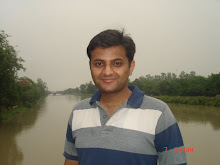Milansar Apartments,
Paschim Vihar,
Delhi
Hello Friends,
I hope you all are fine and doing well in your businesses. Today it’s 22nd June and its Sunday. Usually I don’t plan anything special for this very special day and spend time with my best friend i.e. TV remote control :-) and during surfing I landed up on set max showing “Gandhi My Father” and I decided to see the movie once again. I have already seen the movie in the very first week of release around a year back. Not to mention everything in movie was same but I think this time my perspective towards this great man has changed a lot.
Well, I am not writing this blog to praise Gandhiji or to crtisice his son Harilal (The movie is based on the relations of these two characters). This blog is all about following a leader. Its about giving 100% in the era when there is no media. Its about myths we used to carry through generations (specifically last two) for this man.
I hope you all know that the period British Raj in
There are many myths about Gandhi. I’d like to point out a few of them and hopefully get rid of them for you.
One of the most common and most dangerous myths about Gandhi is that he was a saint. The name—or rather, the title—Mahatma itself means “Great Soul. Gandhi tried to avoid the title, but the people of
Gandhi objected when people called him “a saint trying to be a politician.” He said he was instead “a politician trying to be a saint.” Personally, I go along with Gandhi’s judgment on this.
Another myth about Gandhi is that our immediate post independence leaders followed the path laid by Gandhi, beginning with Nehru, are the inheritors of his tradition and have carried it on.
I wish they had. But really,
They abandoned nonviolent action as soon as they attained power.
Maybe even worse,
Gandhi fought this kind of development. He warned that it would economically ruin
Yes,
Another of the biggest myths about nonviolent action is the idea that Gandhi invented it.
Gandhi is often called “the father of nonviolence.” Well, he did raise nonviolent action to a level never before achieved. Still, it wasn’t at all his invention.
Gandhi and his Indian colleagues in
So, Gandhi was definitely not “the father of nonviolence” in the sense of having invented it. But we might still grant him the title in something of the sense in which we say Isaac Newton “discovered” gravity.
Why aren’t we more aware of such cases—including those in our own history? I think it’s because of something we could call “filtering.”
Probably most of you who’ve worked with cameras know about the kind of filter I mean. The filter fits over the camera lens and blocks out portions of the light—usually certain colors—and lets the remainder pass through to the lens. In effect, the filter selects the portion of light that the camera will “see.”
Each of us too sees the world through our own “filter”—a filter made up of our assumptions, our motivations, and the categories we use to sort out and organize our experience. This filter determines how we see the world.
When we come across something that doesn’t match our assumptions, motivations, and categories, our filter blocks it out. It’s not that we choose to reject it. Consciously, we don’t even perceive it. Or else we perceive it in a partial, distorted form.
It seems that nonviolence has a particularly hard time passing through many people’s filters.
Gandhi practiced two types of Satyagraha in his mass campaigns. The first was civil disobedience, which entailed breaking a law and courting arrest. When we today hear this term, our minds tend to stress the “disobedience” part of it. But for Gandhi, “civil” was just as important. He used “civil” here not just in its meaning of “relating to citizenship and government” but also in its meaning of “civilized” or “polite.” And that’s exactly what Gandhi strove for.
The second form of mass Satyagraha was noncooperation.
This is just what it sounds like. Noncooperation meant refusing to cooperate with the opponent, refusing to submit to the injustice being fought. It took such forms as strikes, economic boycotts, and tax refusals.
Of course, noncooperation and civil disobedience overlapped. Noncooperation too was to be carried out in a “civil” manner. Here too, Gandhi’s followers had to cheerfully face beating, imprisonment, confiscation of their property—and it was hoped that this willing suffering would cause a “change of heart.”
Gandhi saw that the power of any tyrant depends entirely on people being willing to obey. The tyrant may get people to obey by threatening to throw them in prison, or by holding guns to their heads. But the power still resides in the obedience, not in the prison or the guns.
Now, what happens if those people begin to say, “We’re not afraid of prison. We’re even willing to die. But we’re not willing to obey you any longer.”
It’s very simple. The tyrant has no power. He may rant and scream and hurt and destroy—but if the people hold to it, he’s finished.
Gandhi said, “I believe that no government can exist for a single moment without the cooperation of the people, willing or forced, and if people suddenly withdraw their cooperation in every detail, the government will come to a standstill.”
That was Gandhi’s concept of power—the one he’s accused of not having. It’s a hard one to grasp, for those used to seeing power in the barrel of a gun. Their filters do not pass it. And so they call Gandhi idealistic, impractical.
If all this stuff does pass through your filter, you may be well on your way to understanding Gandhi.
With Love,
Dhiraj Srivastava
